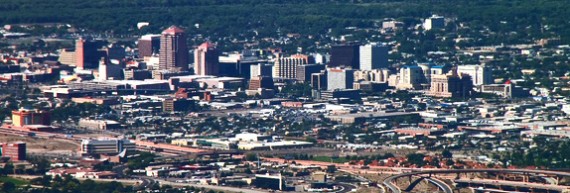Traditionally, Albuquerque has grown outward as fast as it could. The choice is whether we should grow up instead. Mayor Berry has called the 10-year-old impact fee system “unfair” to growth on the edge, to developers and merchant homebuilders. But wasn’t the intent to balance the public costs of growth on the edges with the cost of maintaining the older city? Wasn’t the problem that there were neighborhoods on the West Side that weren’t going to get public parks for another 25 years because there wasn’t any money for them – unless we robbed the existing city. Isn’t the problem that we are robbing the existing city to pay for our way of growing past the horizon?
For years, the city of Albuquerque and the surrounding county and towns have been planning on growth. The path has been clear: Build, move out to the next piece of empty land and build again. The result over the past 20 years has been just that - the urbanized area in and around Albuquerque has grown faster than the population. Perhaps 20 years ago we realized that we, the public, could not afford to keep up with that growth without new taxes on existing homeowners and businesses or without starving old neighborhoods of needed renewal and replacements of old infrastructure.
Alternatively, the Water Utility Authority has had a “utility expansion fee” on new construction for decades now. Albuquerque Public Schools (APS) has explicitly stated a policy to spend 70 percent of capital on renewal and renovation of existing schools and 30 percent on new schools. The city tried to balance the needs of old vs. new with the graduated impact fee system that the Mayor is dismantling. Growth at any cost is good. Is it?
The City Council tried to change direction slightly a decade ago by growing outward a little slower and growing upward a little bit, by filling in and redeveloping the existing city, by increasing housing permits from 8 percent in the old city limits to 15 percent of total permits. By encouraging the construction of new homes in the older parts of the city like Downtown, East Central and North Fourth.
There is the planners’ joke that there are two things that residents hate: sprawl and density. This doesn’t give the City Council many choices. The Planned Growth Strategy suggested that a significant fraction of new houses should be built inside the city; in some cases, that means that those new homes will be in somebody’s “backyard,” and some residents will say, “Not in my back yard!” They’re called “NIMBYs.” Neighborhood associations effectively have veto power over infill and redevelopment – if they don’t want change. But they don’t necessarily have the power to effect positive change instead.
The home builders have pointed out that they need “build-able lots” to build on. They work best and most economically on tracts of, say, 100 acres at a time, not just one acre or one lot. Infill and redevelopment is more complicated than building out to the Rio Puerco or beyond Los Lunas.
Who will be able to broker a new development agreement between developers and neighbors to streamline the process of redevelopment and infill? It is not clear that developers and home builders have the experience to deal with the city, with its public works deficits and neighbors who don’t trust either City Hall or developers. And, of course, time is money, and delays make new houses more expensive than they might be otherwise if the lots existed and an agreement could be struck quickly.
Perhaps the city Office of Neighborhood Coordination might lead such an exercise, but some developers are skeptical. And there’s the problem of recognizing the role and strength of private enterprise. Its job is to make money by selling stuff, including houses. Its job is not to solve world hunger. The role of government and private charity is to leverage human resources to serve human needs that the private sector cannot or will not. But can government broker a complex agreement to address both the need for profits and the social and public needs of an older neighborhood? This may be a role for a nonprofit community development service, a community development corporation.
Residents of older neighborhoods are skeptical of change. As James Howard Kunstler notes in The Geography of Nowhere, change in U.S. cities has not been attractive to residents since World War I. Many starkly modern new buildings have been an affront to settled homeowners. Private parking lots in particular have seldom looked good to neighbors, but they are more privately profitable than single family houses. So it is not surprising that many folks instinctively oppose change of any kind. Better the devil you know.
The challenge is to offer an answer to the question: What’s in it for us? Perhaps there is a quid pro quo, a balance of benefits and costs. The costs may be more buildings and taller buildings in a neighborhood. The benefits might include upgrades to local parks and schools, or some new shops or public services.
There is a growing need to repair and upgrade our decaying infrastructure of older streets, sewers, parks and schools. Redevelopment and impact fees can generate some of the cash needed to pay for this public work, just as new development on the edges pays for some of its concomitant public works.
Here is one scenario to manage change: A coalition of neighborhood associations, such as the North Valley Coalition, would create a nonprofit community development services corporation, a CDC, with public and private funding. The role of this corporation would be to measure the state of the community, assess its needs and learn the potential for infill and redevelopment in the area. Is there a need for more “granny flats” or student apartments? Is there a need for a new assisted living center for the elderly and infirm in the community?
Perhaps the elementary school needs a new playground and kitchen, or the community park needs a bandstand, or the community just needs a neighborhood park or a better library. Residents might say they really need a coffee shop or another grocery store or used-book store they can walk to. What if the trade-off to get all these things is 1,000 new homes and apartments and 100,000 square feet of new or reconstructed retail and office space? The local corporation could lay the groundwork for redevelopment that the community wants, before the private developers come in. Then, working with private landowners and the city Planning and Public Works departments, the local corporation could solicit proposals for rezoning and redevelopment. A planning and design charette or a public workshop with the neighbors, the developers and their architects could produce the zoning and development code in drawings and words that everyone can understand.
Another strategy is for the city to approach a neighborhood coalition and broker the deal. A simple offer is to up-zone the area from R-1 (single-family houses on 5,000 SF lots) to say R-1E, enhanced, with the conditional use of two houses per lot with an accessory or “mother-in-law” apartment instead. Would that simple, top-down, incremental strategy work instead? What is the quid pro quo?
lf the community got “the numbers” right, developers would respond. Cooperation and forward thinking might just be the best strategy for us to shape the future of Albuquerque.
(Feature image via Flickr by Mr. T in DC.)




Responses to “Here’s An Idea For Managing Growth”